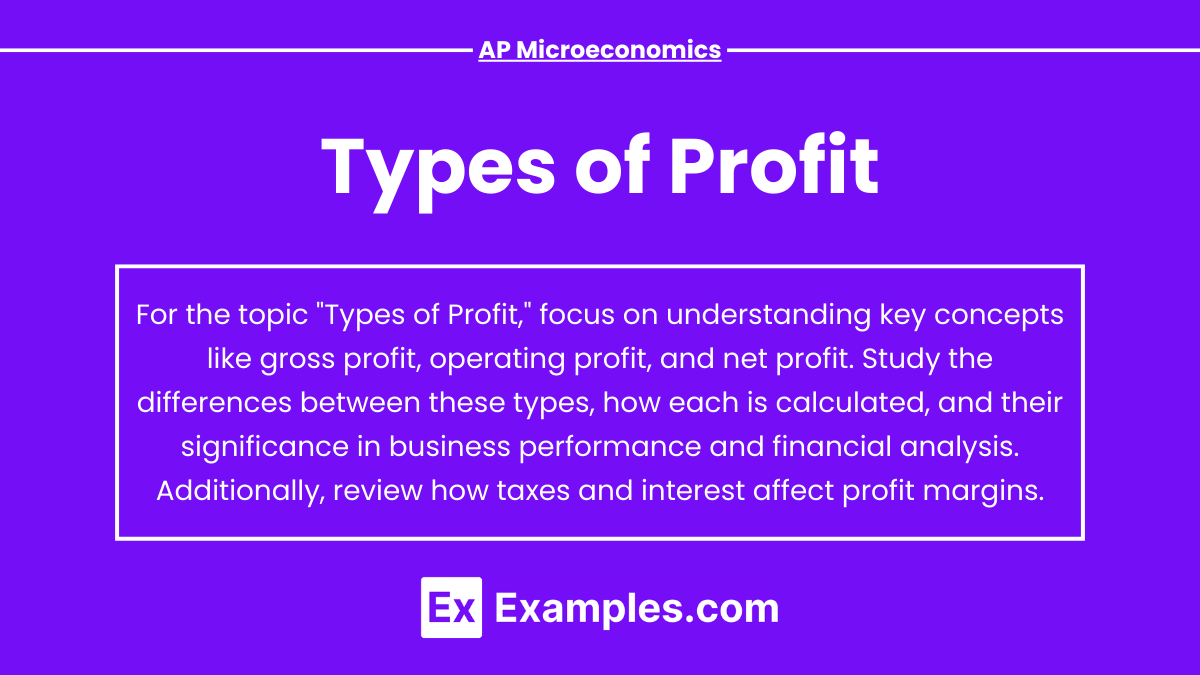In AP Microeconomics, understanding the “Types of Profit” is essential for analyzing firm behavior and market dynamics. Profit can be categorized into accounting profit, economic profit, normal profit, and abnormal (supernormal) profit, each reflecting different cost considerations and profitability measures. These distinctions help explain how firms make decisions, respond to market conditions, and interact within various market structures such as perfect competition and monopoly. Grasping these profit types enables students to evaluate business efficiency and the broader economic implications effectively.
Learning Objectives
By studying “Types of Profit,” you will understand and differentiate between accounting profit and economic profit, including how to calculate each. You will learn to identify normal profit and abnormal (supernormal) profit, and comprehend their implications for firm behavior and market dynamics. Additionally, you will explore how different market structures—such as perfect competition, monopoly, monopolistic competition, and oligopoly—affect profit levels in the short and long run. Mastery of these concepts will enable you to analyze profit-related scenarios and apply graphical analysis effectively in the AP Microeconomics exam.
Understanding the different types of profit is crucial for analyzing firm behavior, market structures, and economic efficiency. In AP Microeconomics, profit can be categorized in several ways based on accounting practices and economic theories. Below is a comprehensive overview of the various types of profit, their definitions, calculations, and implications.
1. Accounting Profit
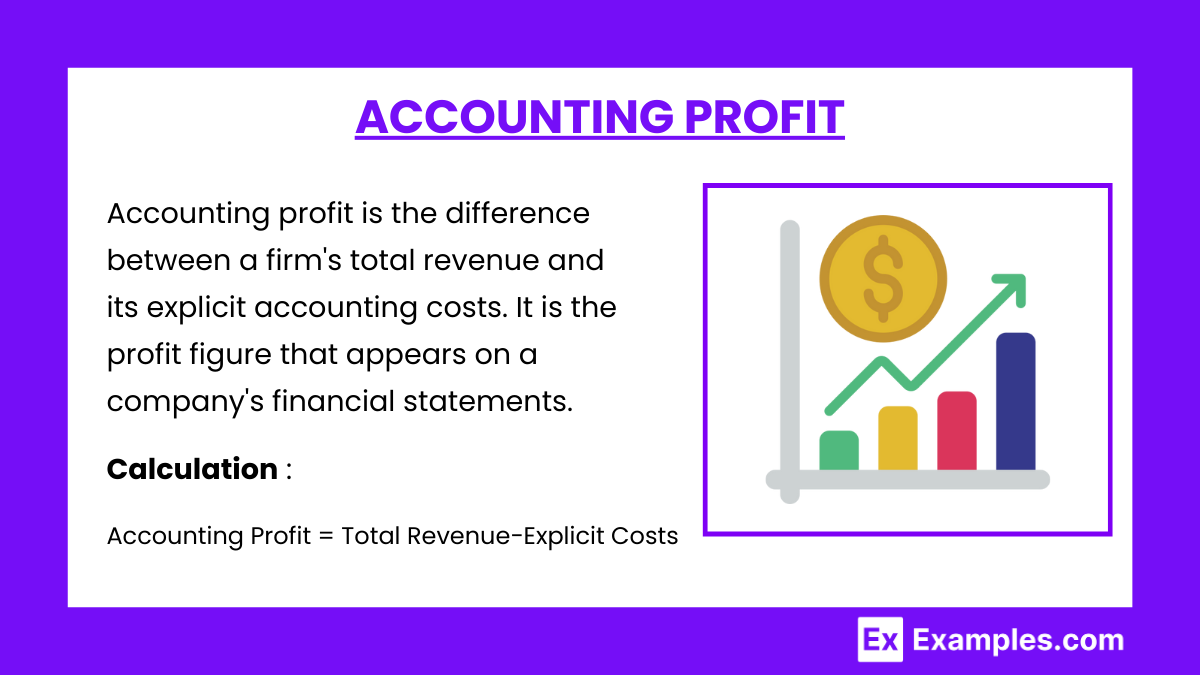
Accounting profit is the difference between a firm’s total revenue and its explicit accounting costs. It is the profit figure that appears on a company’s financial statements.
Calculation Accounting Profit=Total Revenue−Explicit Costs
- Total Revenue (TR): The total income from selling goods or services.
- Explicit Costs: Direct, out-of-pocket payments for costs like wages, rent, and materials.
Example
If a firm has a total revenue of $500,000 and explicit costs of $300,000:Accounting Profit=$500,000−$300,000=$200,000
Implications
- Used for financial reporting and tax purposes.
- Does not consider implicit costs (opportunity costs).
2. Economic Profit
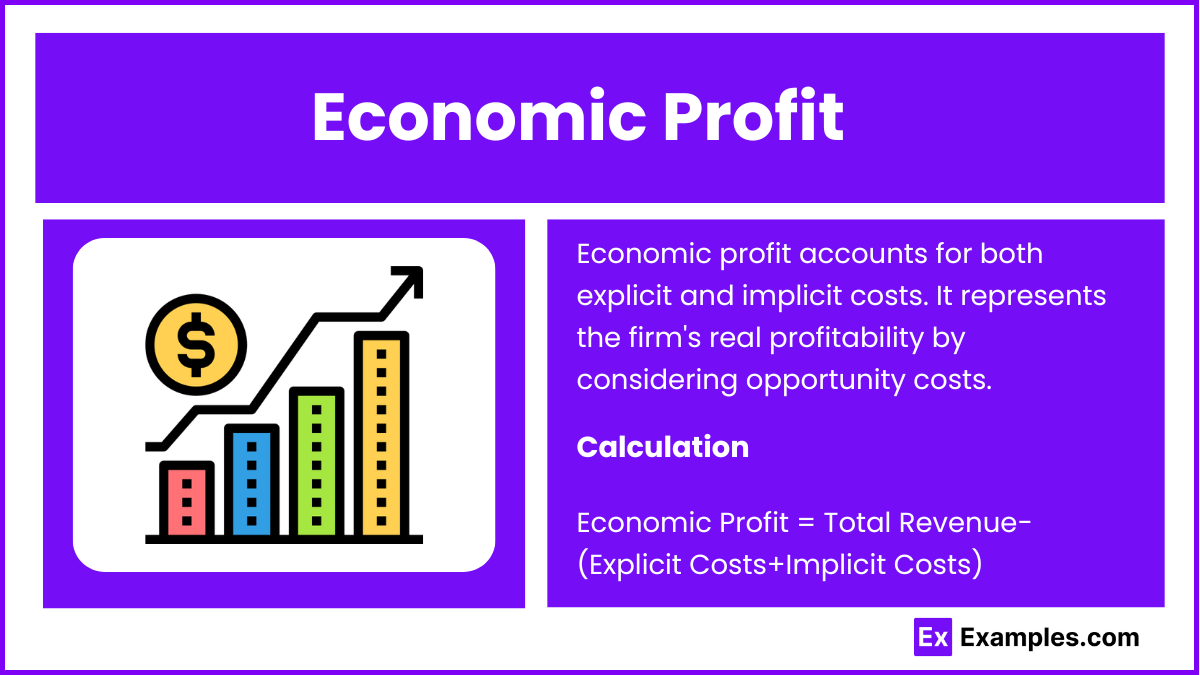
Economic profit accounts for both explicit and implicit costs. It represents the firm’s real profitability by considering opportunity costs.
Calculation Economic Profit=Total Revenue−(Explicit Costs+Implicit Costs)
Implicit Costs: Indirect costs, such as the opportunity cost of the owner’s time or resources.
Example
Using the previous example with an implicit cost of $50,000:
Economic Profit = $500,000−($300,000+$50,000) = $150,000
Implications
- Indicates whether resources are being used efficiently.
- Positive economic profit suggests resources could be better employed elsewhere.
- Zero economic profit (normal profit) indicates optimal resource allocation.
3. Normal Profit
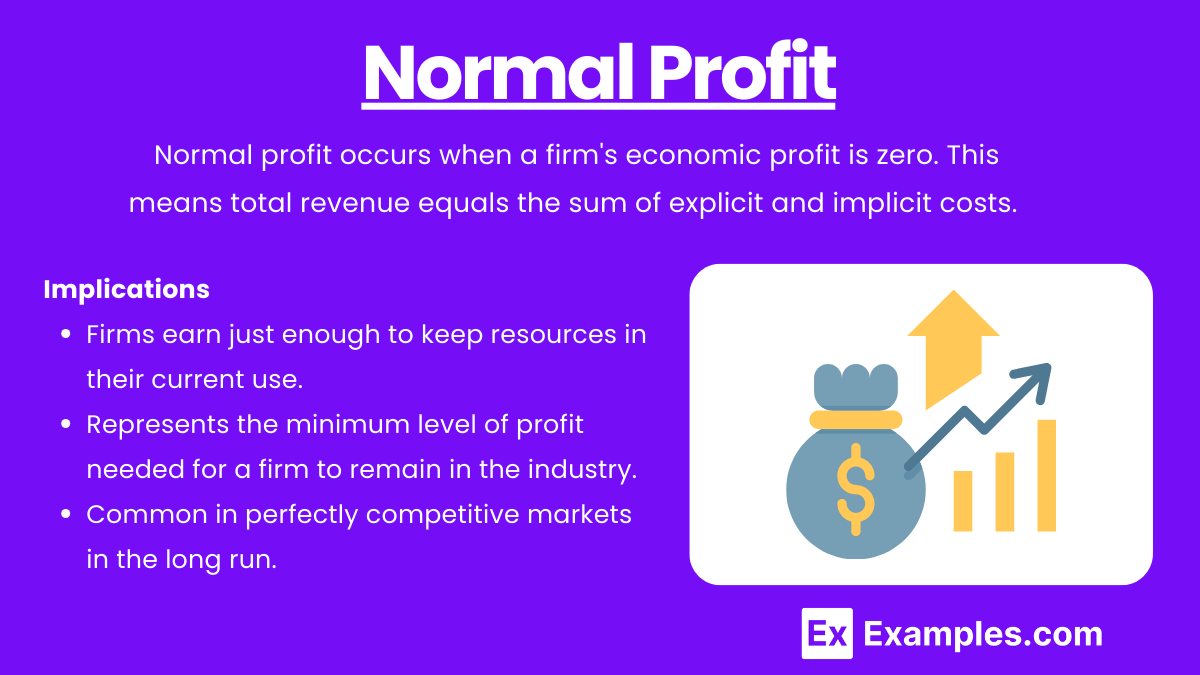
Normal profit occurs when a firm’s economic profit is zero. This means total revenue equals the sum of explicit and implicit costs. It signifies that the firm is covering all its opportunity costs.
Calculation Economic Profit=0⇒Total Revenue=Explicit Costs+Implicit Costs
Implications
- Firms earn just enough to keep resources in their current use.
- Represents the minimum level of profit needed for a firm to remain in the industry.
- Common in perfectly competitive markets in the long run.
Example
If Total Revenue = $500,000, Explicit Costs = $300,000, and Implicit Costs = $200,000:$500,000=$300,000+$200,000⇒Economic Profit=0 (Normal Profit)
4. Abnormal Profit (Supernormal Profit)
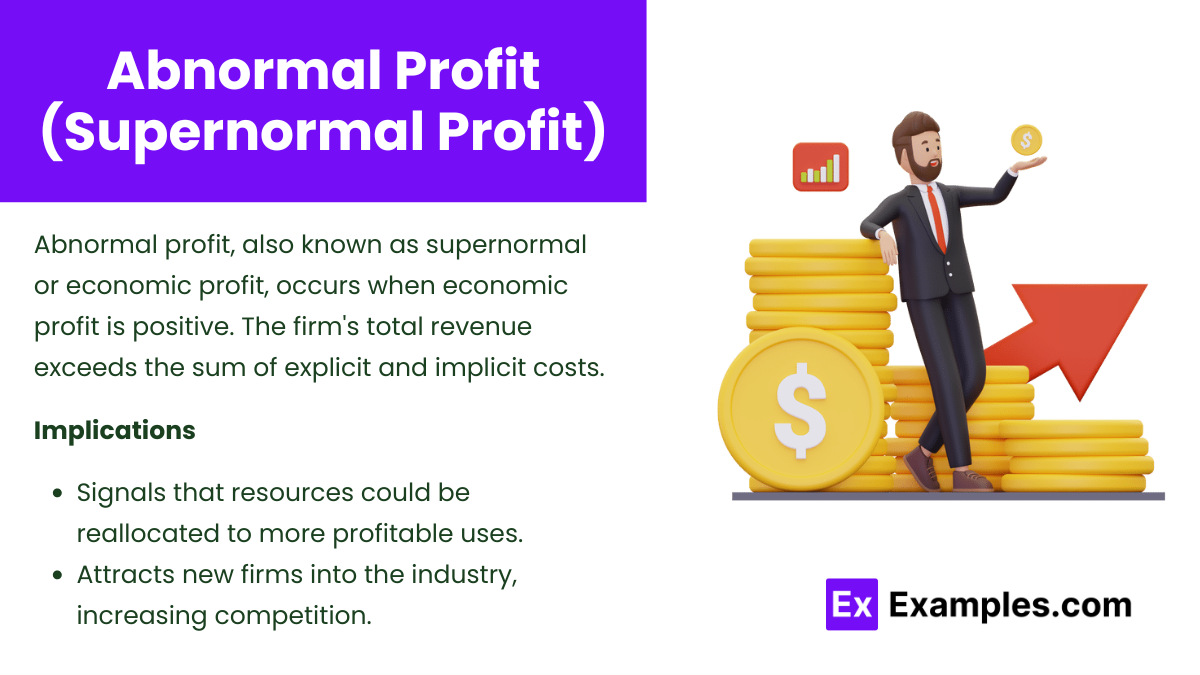
Abnormal profit, also known as supernormal or economic profit, occurs when economic profit is positive. The firm’s total revenue exceeds the sum of explicit and implicit costs.
Calculation Economic Profit>0⇒Total Revenue>Explicit Costs+Implicit Costs
Implications
- Signals that resources could be reallocated to more profitable uses.
- Attracts new firms into the industry, increasing competition.
- Typically observed in the short run, especially in less competitive markets.
Example
If Total Revenue = $600,000, Explicit Costs = $300,000, and Implicit Costs = $200,000:Economic Profit=$600,000−($300,000+$200,000)=$100,000 (Supernormal Profit)
5. Zero Profit (Break-Even Point)
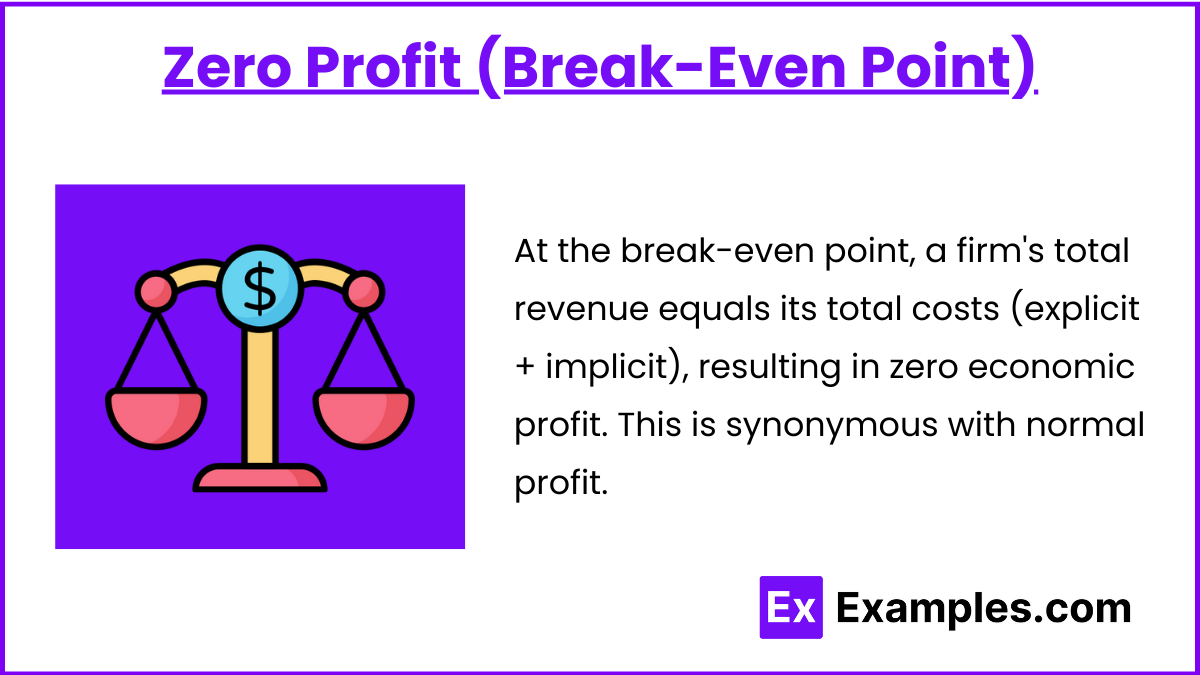
At the break-even point, a firm’s total revenue equals its total costs (explicit + implicit), resulting in zero economic profit. This is synonymous with normal profit.
Implications
- The firm is covering all its costs, including opportunity costs.
- No incentive for entry or exit in the market.
- Indicative of long-run equilibrium in perfectly competitive markets.
6. Short-Run vs. Long-Run Profits

Short-Run Profits
- Firms may earn abnormal profits due to temporary market conditions, lack of competition, or barriers to entry.
- In the short run, some inputs are fixed, allowing firms to respond slowly to changes.
Long-Run Profits
- In the long run, the entry of new firms in response to abnormal profits increases competition.
- As competition intensifies, economic profits are driven to zero (normal profit) in perfectly competitive markets.
- Firms can adjust all inputs, ensuring resources are allocated efficiently.
Examples
Example 1. Accounting Profit: A Local Café’s Financial Success
Sunny Brew Café operates in a bustling neighborhood, offering a variety of coffees and pastries. At the end of the fiscal year, Sunny Brew Café calculates its total revenue from sales to be $250,000. The explicit costs, including expenses for ingredients, employee wages, rent, utilities, and marketing, amount to $180,000.
Calculation:
Accounting Profit = $250,000−$180,000 = $70,000
Explanation: Sunny Brew Café’s accounting profit is $70,000. This figure reflects the difference between the café’s total revenue and its explicit costs. Accounting profit is crucial for financial reporting, tax calculations, and assessing the café’s short-term financial health. However, it does not account for implicit costs such as the owner’s time or alternative investments.
Example 2. Economic Profit: A Tech Startup’s True Profitability
InnovateX Solutions, a tech startup, generates a total revenue of $1,200,000 in its first year. The explicit costs, including salaries, software licenses, office rent, and marketing, are $800,000. Additionally, the founder invested $200,000 of personal savings into the business and could have earned $100,000 by working for another company instead.
Calculation:
Economic Profit = $1,200,000−($800,000+$100,000) = $300,000
Explanation: InnovateX Solutions’ economic profit is $300,000. This calculation subtracts both explicit costs and implicit costs (opportunity costs) from total revenue. A positive economic profit indicates that the startup is not only covering all its costs but also providing a return above the next best alternative, showcasing true profitability and efficient resource utilization.
Example 3. Normal Profit: A Freelance Graphic Designer Covering All Costs
Creative Designs by Alex is a freelance graphic designer. Over the year, Alex earns $60,000 from various projects. The explicit costs include software subscriptions, marketing expenses, office supplies, and other direct costs, totaling $40,000. Additionally, Alex foregoes a potential salary of $20,000 by choosing freelancing over a traditional job.
Calculation:
Economic Profit = $60,000−($40,000+$20,000) = $0
Explanation: Alex’s economic profit is zero, indicating normal profit. This means that Creative Designs by Alex is covering all explicit and implicit costs, including the opportunity cost of not taking the salaried job. While there is no excess profit, Alex is compensated adequately for the time and resources invested, making it a sustainable business venture.
Example 4. Abnormal (Supernormal) Profit: A Pharmaceutical Company’s Market Dominance
HealthPlus Pharmaceuticals holds a patent for a groundbreaking medication that treats a widespread chronic condition. In a given year, the company reports total revenue of $5,000,000. The explicit costs, including research and development, production, marketing, and distribution, amount to $3,000,000. The implicit costs, such as the opportunity cost of capital invested in other ventures, are $500,000.
Calculation:
Economic Profit = $5,000,000−($3,000,000+$500,000) = $1,500,000
Explanation: HealthPlus Pharmaceuticals earns an economic profit of $1,500,000, classified as abnormal or supernormal profit. This significant profit arises due to the company’s market dominance and the temporary monopoly granted by the patent. Abnormal profits signal that the firm is earning more than the standard returns on its resources, often attracting new competitors once the patent expires and barriers to entry diminish.
Example 5. Zero Profit (Break-Even Point): A Family-Owned Bakery Sustaining Operations
Sweet Treats Bakery operates in a competitive local market. Over the past year, the bakery generated total revenue of $150,000. The explicit costs, including ingredients, wages, rent, utilities, and other direct expenses, totaled $100,000. Additionally, the owner’s time and resources have an implicit cost valued at $50,000, representing the income the owner could have earned elsewhere.
Calculation:
Economic Profit = $150,000−($100,000+$50,000) = $0
Explanation: Sweet Treats Bakery achieves zero economic profit, also known as breaking even or earning normal profit. This means that the bakery’s total revenue precisely covers all explicit and implicit costs. While there is no excess profit, the owner is compensated for the use of their resources, making the business sustainable. In the long run, zero economic profit indicates that the firm is efficiently allocating its resources within the market.
Multiple Choice Questions
Question 1
A company has total revenue of $800,000, explicit costs of $500,000, and implicit costs of $200,000. What is the company’s economic profit?
A) $100,000
B) $200,000
C) $300,000
D) $500,000
Answer: A) $100,000
Explanation: Economic Profit is calculated as Total Revenue minus the sum of Explicit and Implicit Costs.
Economic Profit = $800,000−($500,000+$200,000) = $800,000−$700,000 = $100,000
Since the economic profit is positive ($100,000), the company is earning an abnormal (supernormal) profit.
Question 2
In the long run, firms in a perfectly competitive market earn:
A) Abnormal profits
B) Normal profits
C) Economic losses
D) Supernormal profits
Answer: B) Normal profits
Explanation: In a perfectly competitive market, free entry and exit of firms ensure that any abnormal profits are eliminated in the long run. When firms earn abnormal profits, new firms enter the market, increasing supply and driving down prices until only normal profit (zero economic profit) is achieved. Therefore, in the long run, firms earn normal profits, where total revenue equals total costs, including opportunity costs.
Question 3
Which of the following best describes normal profit?
A) Total revenue exceeds both explicit and implicit costs.
B) Total revenue equals explicit costs but not implicit costs.
C) Total revenue equals the sum of explicit and implicit costs.
D) Total revenue is less than explicit costs.
Answer: C) Total revenue equals the sum of explicit and implicit costs.
Explanation: Normal Profit occurs when a firm’s economic profit is zero, meaning that total revenue exactly covers both explicit costs (out-of-pocket expenses) and implicit costs (opportunity costs). This indicates that the firm is earning just enough to keep its resources in their current use without any additional profit.
Economic Profit = Total Revenue−(Explicit Costs+Implicit Costs) = 0
Thus, Total Revenue = Explicit Costs + Implicit Costs.
Key Concepts Reviewed:
- Accounting Profit vs. Economic Profit: Accounting profit considers only explicit costs, while economic profit includes both explicit and implicit costs.
- Normal Profit: A situation where economic profit is zero, indicating that a firm covers all its costs, including opportunity costs.
- Abnormal (Supernormal) Profit: Occurs when economic profit is positive, signaling that a firm is earning more than its total costs.

